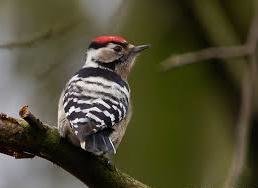 |
| Marsh tit (library picture) |
 |
| Willow tit (library picture) |
 |
| Lesser spotted woodpecker (photo Steve Oakes) |
Funding was secured by Natural England to undertake woodland bird surveys in 2016. The work was done in the following four woodland SSSI's (Sites of Special Scientific Interest) in Sussex and Kent: Ashburnham; St Leonard’s Forest/Old Copse; Cow Wood and Harry’s Wood; West Blean and Thornden Woods. All four of these woodland SSSI's are notified for woodland and woodland breeding bird assemblage.
The field work undertaken aimed to:
• Check for presence of all resident woodland birds using appropriate survey techniques.
• Confirm breeding and breeding behaviour of key early woodland birds using appropriate
specialist survey techniques.
As funding was for the period prior to the start of the financial year in April 2016 breeding surveys could only be completed for those species that set up on territory early: namely lesser spotted woodpecker, willow tit and marsh tit. However, these are three of the most important woodland birds in a South East context. All three are rare and declining and all three require specialist survey techniques as they are unlikely to be recorded accurately using standard assemblage monitoring techniques. Surveyors also recorded the presence of other woodland birds during the survey.
As an additional comparison site the surveys of the area of Blean woods managed by the RSPB
are included.
Old Copse is Unit 1 (part) marked in purple . For the purposes of the RSPB survey, Old Copse was included as part of the greater St. Leonard's Forest area, which of course - historically - it was.
St. Leonard’s Forest survey areas (marked in purple)
Area: Unit 3: 2.08
Unit 4: 46.83
Unit 5: 9.21
Unit 1 (part): 5.6 (Permission to access larger area of Unit 1, in red, not granted)
Total: 63.72
Ownership: Unit 3: Forestry Commission
Unit 4: Forestry Commission
Unit 5: Forestry Commission
Unit 1 (part): Private owner - Sarah Axon
Three surveyors were used, all of whom had expertise in woodland bird surveys and a history of
previous work with the RSPB. The surveyors were Dave Burges (Ashburnham), Martin Allison (St Leonard's Forest and Old Copse, Cow Wood and Harry's Wood) , and Bob Gomes (West Blean and Thornden Woods.)
Report on St. Leonard’s Forest.(including Old Copse)
Dates of visits
In addition to the five dawn survey visits, a reconnaissance visit was also made on 11th February
so that the surveyor could familiarise himself with the layout of the wood. The dates and principal
objective of each visit is given in table 6 below.
Table 6. Dates and objectives of visits to St. Leonard’s Forest in February/March 2016.
Visit number Date Objective
1 11/02/16 Reconnaissance
2 16/02/16 Marsh/willow tit survey
3 02/03/16 Lesser spotted woodpecker survey
4 08/03/16 Lesser spotted woodpecker survey
5 17/03/16 Marsh/willow tit survey
6 21/03/16 Lesser spotted woodpecker survey
Target species
A total of 6 to 7 marsh tit territories were identified (Table 7). One territory (at TQ215309) may
have been just outside the survey area). Two of the territories were in Old Copse. They tended to
be in the wetter areas close to Gills or lakes (figure 7). St. Leonard’s Forest is a wet woodland
compared to sites further east such as Tudeley and Blean and it seems probable that this is an
important factor in the good numbers of marsh tits still present.
Table 7. Location of marsh tit territories at St. Leonard’s Forest based on five visits in March 2016.
Territory No Grid reference Location
1 TQ215309 Lily Beds
2 TQ208304 Sheepwash Gill
3 TQ212303 Scragged Oak Hill
4 TQ211301 Inholme Gill
5 TQ208300 Sheepwash Wood
6 TQ219294 Old Copse
7 TQ218292 Old Copse
No willow tits were found. Willow tit also depends on wetness but has a preference for younger
woodlands dominated by birch, hawthorn, willow, hazel and alder. It uses scrub vegetation of 2 to
4 m in height and is possible that this was not present in sufficient quantity on the site to retain
willow tit. However, it should be noted that willow tit has suffered widespread declines so it is
unlikely that its loss here is simply a site specific issue.
No lesser spotted woodpecker were found within the survey area. There are areas of St. Leonard’s
that are conifer plantation, some of it recently felled, which is less suitable for this species than
deciduous woodland. That may be a factor, especially to the north of the survey area. However the
south of the survey area included wet deciduous woodland that looked very suitable habitat. In fact
there was a record of a calling bird from outside the woodland boundary. It was heard on one
occasion south of the Hammerpond Road car park. It is possible that the southern part of the
survey area was in the territory of this bird but, at the least, its presence suggests that this species
might re-colonise St. Leonard’s Forest in the future if there is enough suitable habitat. Replacing
conifer blocks with deciduous woodland and increasing the quantity of deadwood would both be
beneficial for this species.
It is hoped that the survey will be repeated and developed in April, and July/August this year. It will be interesting to know if our work done in the Old Copse wet wood, birchwood, and the Scots Pine Plantation during the past year has had any effect on the Marsh Tit, Willow Tit, and Lesser Spotted Woodpecker population.
Link to the full report:

No comments:
Post a Comment